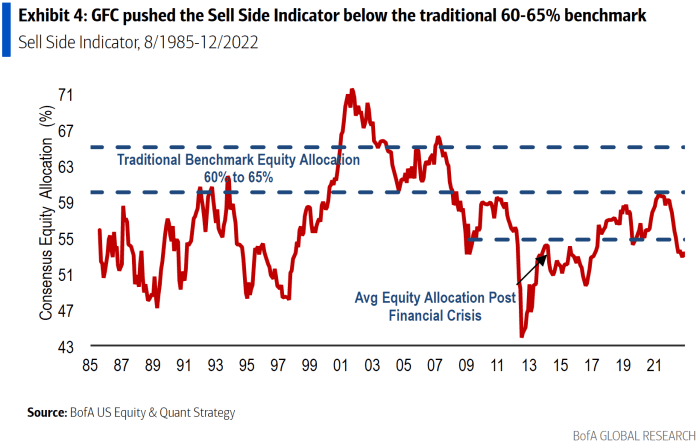Recommended allocations to stocks have dropped to levels that historically have sent a contrarian, bullish signal to the U.S. stock market, according to BofA Global Research.
Thank you for reading this post, don't forget to subscribe!Bank of America’s sell-side indicator, which tracks the average recommended allocation to stocks by U.S. sell-side strategists, declined to 53% in December as the S&P 500 suffered a monthly drop of around 6%, according to a BofA Global Research note Tuesday. When the indicator was at current levels or lower historically, the S&P 500’s returns over the subsequent 12 months were positive 95% of the time while the median 12-month return was 21%, the note shows.
While the sell-side indicator remains in “neutral” territory, it ended 2022 just 1.5 percentage points from a more predictive “buy” signal — “the closest it has been to ‘buy’ since 2017,” BofA equity and quantitative strategists said in the note.
The indicator suggests an expected price return of 16% for the S&P 500 over the next 12 months to around 4,400, according to the strategists. It’s one of six inputs into BofA’s 2023 year-end price target for the S&P 500 of 4,000.
“Wall Street’s consensus equity allocation has been a reliable contrarian indicator over time,” the strategists said. “In other words, it has been a bullish signal when Wall Street strategists were extremely bearish, and vice versa.”
The S&P 500 plunged 19.4% in 2022, its worst year since 2008 as it snapped a three-year win streak, according to Dow Jones Market Data.
“One reason we are more constructive on equities in 2023 is the big drop in sentiment during 2022,” the strategists wrote.
The average recommended allocation to stocks fell last year while the average recommended holding of bonds rose to 34%, according to their note. That brought “the ratio of stock vs. bond allocations to its lowest level since 2016 at 1.6x,” compared with a post-global financial crisis average of 1.8x, the strategists said.
Traditionally, the “normal” equity allocation for a balanced fund is 60-65%, according to the BofA report, which highlighted that the 2008 financial crisis pushed the sell-side indicator “below that band for the first time since 2000.”

BOFA GLOBAL RESEARCH NOTE DATED JAN. 3, 2023
“Wall Street recommended underweighting equities through the entire bull market of the 1980s and 1990s as well as the 2009 to 2020 bull,” the strategists said.
The U.S. stock market kicked off 2023 trading higher at the opening bell on Tuesday, before quickly giving up gains as concerns over a potentially looming recession persisted. The S&P 500
SPX,
was down 0.8% in early afternoon trading at around 3,807, while the Dow Jones Industrial Average
DJIA,
fell 0.6% and the Nasdaq Composite dropped 1.2%, according to FactSet data, at last check.
Meanwhile, bonds were trading higher, with the iShares Core U.S. Aggregate Bond ETF
AGG,
up 0.5% and the iShares 20+ Year Treasury Bond ETF
TLT,
rallying 1.8% in early afternoon trade Tuesday, FactSet data showed.
Sign up for ETF Wrap, our weekly newsletter on exchange-traded funds.

